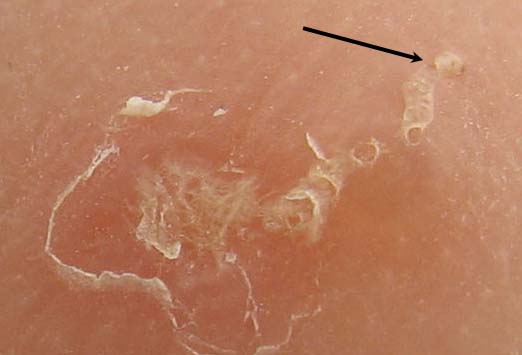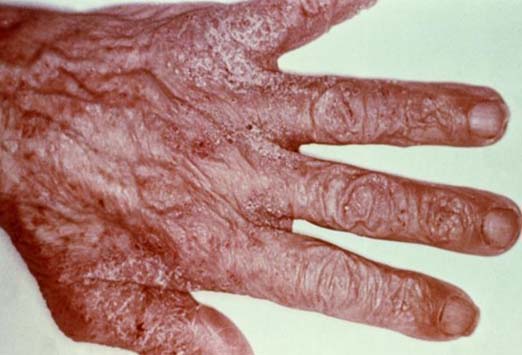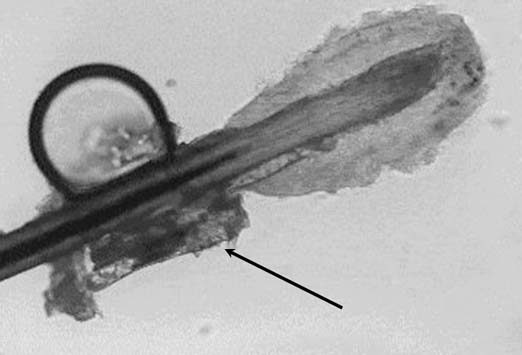Mites
 “Mite” is a term commonly used to refer to a group of insect-like organisms, some of which bite or cause irritation to humans. While some mites parasitize animals, including man, others are scavengers, some feed on plants, and many prey on insects and other arthropods. In fact, there are nearly as many different types of mites as there are insects. Like their relatives, the ticks, mites pass through four stages of development: egg to larva to nymph to adult. All stages have eight legs except the six-legged larva.
“Mite” is a term commonly used to refer to a group of insect-like organisms, some of which bite or cause irritation to humans. While some mites parasitize animals, including man, others are scavengers, some feed on plants, and many prey on insects and other arthropods. In fact, there are nearly as many different types of mites as there are insects. Like their relatives, the ticks, mites pass through four stages of development: egg to larva to nymph to adult. All stages have eight legs except the six-legged larva.
Most mites never come in contact with humans, but some that do can affect a person’s health. Yet, in many situations where mites or other “invisible” arthropods are believed to be biting or “attacking” people, no causative organism is present. The irritation may be real or imagined: real, due to mechanical, chemical or other inanimate irritants, or imagined due to a psychological disorder.
Mites are invertebrates of the class Arachnida that can cause parasitic infections in humans. Mites are related to spiders and have 8 legs, as shown, unlike bedbugs and lice, which are insects and have six legs. Mites are an incredibly diverse group, with more than 48,000 species, but only a few have clinical implications for humans. Sarcoptes scabiei, shown, is a parasitic mite that causes scabies in humans. Scabies is a worldwide health problem that flourishes in areas of overcrowding, delayed diagnosis and treatment, and poor public education. Transmission is via direct and prolonged contact with an infected individual, but infected fomites in bedding or clothing can survive for 3 days.
The life cycle of a mite lasts 30 days and is spent in the human epidermis. Mite eggs are hatched in the superficial skin layers, where they mature into adult mites. They secrete proteases that allow them to degrade the stratum corneum and feed on the dissolved tissue. Fecal matter left behind the migrating mite produces the stereotypical burrows. Most patients are infected with 10-100 mites, but those who are immunocompromised may harbor more than a million, in a condition termed "crusted scabies" (formerly "Norwegian scabies"). The primary clinical symptoms is intense pruritus secondary to a hypersensitivity reaction. The most severe complication is bacterial superinfection.

While mites rarely transmit disease to humans in the United States, they definitely impact health in ways that range from simply being a nuisance when they enter homes in large numbers, to inflicting severe skin irritation that can cause intense itching. The most commonly encountered mites, including those that can adversely affect human health, are listed below.
Clover Mites: This mite sometimes enters homes and other buildings by the thousands, causing panic among residents. Though they do not bite or cause health-related problems, clover mites can be a nuisance. If smashed when they crawl over carpets and drapery, the mites leave a red stain. Clover mites can be red, green or brown, and have front legs that are about twice as long as their other legs. They feed on clover, ivy, grasses, fruit trees and other plants. Well-fertilized lawns are favored. Clover mites enter homes when their food plants are removed or dry up. They are most active in fall, and will seek refuge in structures as colder weather approaches, when molting (shedding skin) and when laying eggs. Typical of many mite species, all clover mites are females capable of laying viable eggs without fertilization. They have no need for male mites!
House Dust Mites: Much information (and misinformation) has appeared in recent years about house dust mites. Virtually invisible to the naked eye, house dust mites are nevertheless real. It has been shown that, like cockroaches, dust mites and their feces can become airborne and are one of the most common indoor allergens. That is, most persons diagnosed as being allergic to “house dust” are actually allergic to the dust mites whose bodies and feces are major components of dust. Roaches and dust mites have also been implicated in triggering asthma attacks. But, unlike rodent mites, itch mites and chiggers, skin irritation is rarely caused by exposure to dust mites. Although they may “hitchhike” on clothing, dust mites do not live on people. They feed primarily on dander, flakes of dead skin that fall from people and animals. Upholstered furniture, pillows and mattresses typically harbor more dust mites than carpeting.
Itch Mites: These mites prey upon insects. Species including the straw itch mite (P. tritici) infest stored products. Humans are bitten when they contact straw, hay, grasses, leaves, seeds or similar materials harboring the mites. Another species (P. herfsi) also attacks insects living in sheltered locations, including the larvae of midges (gnat-like flies) in leaf galls, and the eggs of cicadas beneath tree bark. When separated from their insect prey, itch mites may contact and bite other animals including humans.
The mites cannot be seen and the bites are not felt, but leave itchy red marks that can resemble a skin rash. When itch mite populations ‘explode,’ people and other animals may receive numerous bites. Fortunately, the mites cannot live on humans, do not survive indoors, and are not known to transmit disease.
Rodent and Bird Mites: Rodent and bird mites may bite people when their hosts die or abandon their nests. Three types of rodent mites readily bite humans: the house mouse mite (Liponyssoides saguineus), spiny rat mite (Laelaps echidnina) and tropical rat mite (Ornithonyssus bacoti). The house mouse mite prefers to suck the blood of mice, but also will bite rats and people, often causing a rash around the bite. They prefer warm places (e.g., around pipes and furnaces) where rodents live. The spiny rat mite feeds on rats at night and hides by day in cracks and crevices around rat nests and resting places. The tropical rat mite’s bite is painful and causes skin irritation and itching.
Mites that normally infest birds also bite people. The northern fowl mite (Ornithonyssus sylviarum) and chicken mite (Dermanyssus gallinae) primarily infest chickens, but also pigeons, starlings and sparrows. The northern fowl mite cannot survive for more than a month off its host, while the chicken mite hides in cracks and crevices near bird nests during the day and feeds by night. Cheyletiella mites infest both birds and mammals. They may prey on other mites and insects living on the host’s skin. They can cause a mange-like condition in pets, and itching in people who handle infested pets. They do not stay long on humans.
Chiggers: Two species of chigger mites attack humans and other mammals, birds and reptiles. The nymph and adult stages prey on insects. It is the six-legged larval stage that typically feeds on rodents or ground dwelling birds but will bite people when they are available. Chigger larvae are red to yellow in color and appear as scarcely visible specks. When they detect the carbon dioxide exhaled by an animal, they climb on soil or vegetation and wave their front legs to contact it, then grasp it with their mouthparts. They do not suck blood but cut into the skin, inject skin-digesting saliva and suck up the liquefied skin. If not dislodged, the chigger will feed for several days. The bite becomes inflamed, hardens and itches. Chiggers spend most of their lives in cracks in the soil. They are typically found in rural, less disturbed areas, but can persist for years on soil in new subdivisions.
Scabies Mites: Sarcoptes scabiei are mites that infest mammals, including man. Most human infestations result from person-to-person contact. Although they can transfer from animals to humans and vice versa, several types of scabies mites exist, each having a preferred host species on which it reproduces. In dogs, scabies mites cause mange. Scabies is the most common and important condition resulting from mite infestation of humans. Unlike other mites, scabies mites actually burrow up to 3cm into the skin to lay eggs. The mites are believed to feed on skin and secretions. The entire life cycle (10-17 days for human-infesting scabies mites) is spent on their host. Without a host, they survive only a few days. In previously unexposed individuals, a scabies infestation may go unnoticed for more than a month. Then, severe irritation and itching develops, especially at night.
 In adults, scabies infection usually occurs on the flexor wrists, interdigital web spaces of the hands (shown), dorsal feet, axillae, elbows, waist, buttocks, and genitalia. Pruritic papules and vesicles on the scrotum and penis in men or areolae in women are characteristic. Infants and children may have diffuse lesions on the face, scalp, neck, palms, and soles. Primary scabies is typically evident as small papules, vesicles, and burrows, whereas secondary lesions are due to rubbing and scratching. Diagnosis can be made with light microscopic identification of mites, larvae, ova, or fecal pellets.
In adults, scabies infection usually occurs on the flexor wrists, interdigital web spaces of the hands (shown), dorsal feet, axillae, elbows, waist, buttocks, and genitalia. Pruritic papules and vesicles on the scrotum and penis in men or areolae in women are characteristic. Infants and children may have diffuse lesions on the face, scalp, neck, palms, and soles. Primary scabies is typically evident as small papules, vesicles, and burrows, whereas secondary lesions are due to rubbing and scratching. Diagnosis can be made with light microscopic identification of mites, larvae, ova, or fecal pellets.
Histologic examination of a skin biopsy specimen may reveal mites (arrows) within a hyperkeratotic stratum corneum, but a dermal infiltrate composed of lymphocytes, histiocytes, mast cells, and eosinophils is characteristic. Treatment of scabies consists of a scabicidal agent (eg, permethrin cream or oral ivermectin), antipruritic agents, and antimicrobials if the patient is secondarily infected. All household members and close personal contacts should be treated. Clothes, linens, and towels need to be laundered with hot water. Patients should typically be reevaluated 2-4 weeks after treatment to ensure adherence and mite eradication.
 Demodicosis is an infection of the eyelid caused by the mite Demodex folliculorum. The mites infest the eyelash hair follicles, where they feed off of sebaceous gland cells. Accumulation of mite waste material may cause follicular plugging, leading to dry eyes and chalazion formation. D folliculorum has also been implicated in pityriasis folliculorum, with rosacealike papules, and diffuse erythema. On examination, patients may have thickened or scaled lids, loss of lashes, conjunctival inflammation, or decreased vision. Treatment involves a combination of brushing, diluted baby shampoo washings, and antibiotic ointment applications. Prognosis is typically very good.
Demodicosis is an infection of the eyelid caused by the mite Demodex folliculorum. The mites infest the eyelash hair follicles, where they feed off of sebaceous gland cells. Accumulation of mite waste material may cause follicular plugging, leading to dry eyes and chalazion formation. D folliculorum has also been implicated in pityriasis folliculorum, with rosacealike papules, and diffuse erythema. On examination, patients may have thickened or scaled lids, loss of lashes, conjunctival inflammation, or decreased vision. Treatment involves a combination of brushing, diluted baby shampoo washings, and antibiotic ointment applications. Prognosis is typically very good.
